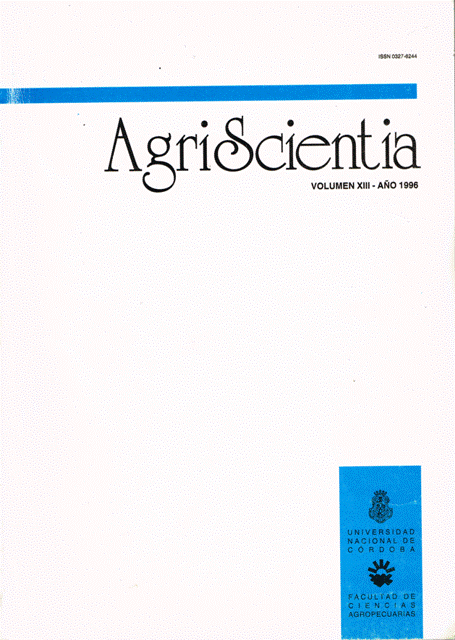Adaptive mass selection in an exotic population of maize (Zea mays L.). Preliminary results
Main Article Content
Abstract
Mass selection has been indicated to enhance adaptation of exotic germplasm without losing favorable genetic components. The objective of this work was to evaluate the selection for adaptation in an exotic population of maize. A original population formed by intercrossing 16 exotic genotypes was improved for prolificacy, disease tolerance, and ear length for two cycles. The cycles of selection together with the original population were evaluated in trials during the summers of 1993/94 and 1994/95. A set of 110 individual half sib progenies, derived from the second cycle, prolific, non-prolific, or with higher harvest index were evaluated to test if differences in individual selection criteria correlated with the performance of resulting populations. The IC progenies had a slightly lower performance than the prolific or non-prolific ones. Selection was efficient in increasing prolificacy, reducing lodging and ear height, but increasing days to flowering. Yield showed a tendency to increase but without statistical significance.
Article Details

This work is licensed under a Creative Commons Attribution-ShareAlike 4.0 International License.
How to Cite
References
Austin, R. B. (1980). Physiological limitations to cereal yields and ways of reducing them by breeding. En R. G. Hurd et al. (Eds.), Opportunities for increasing crop yields (pp. 3-18). Pitman Publ. Ltd.
Biasutti, C. A., & Barrandeguy, M. A. (1988). CIMMYT International Maize Testing Program: Experimental Variety Trials EVT 16B. CIMMYT Final Report.
Biasutti, C. A., & Peiretti, D. A. (1992). Asociación de caracteres morfológicos en poblaciones de maíz (Zea mays L.) en condiciones de estrés y no estrés hídrico. Agriscientia, 9(2), 59-64.
Biasutti, C. A., Maldonado, F., Peiretti, D. A., Quiroga, G. B., Ryan, A. B., & Nazar, M. C. (1993). Estabilidad de los componentes del rendimiento en maíz (Zea mays L.) a través de distintos ambientes. En XXVI Congreso Argentino de Genética y II Jornadas Argentino Uruguayas de Genética, Posadas, Misiones (p. 60).
Burgess, J. C., & West, D. R. (1993). Selection for grain yield following selection for ear height in maize. Crop Science, 33, 679-682.
Chaves, L. J., & de Miranda Filho, J. B. (1992). Plot size for progeny selection in maize (Zea mays L.). Theoretical and Applied Genetics, 84, 963-970.
Compton, W. A., Mumm, R. F., & Mathema, B. (1979). Progress from adaptive mass selection in incompletely adapted maize populations. Crop Science, 19, 531-533.
Donald, G. M., & Hamblin, J. (1976). The biological yield and harvest index of cereals as agronomic and plant breeding criteria. Advances in Agronomy, 28, 361-405.
Drapala, W. J., & Jones, M. M. (1990). Analyses of common treatments in randomized complete block design and augmented randomized complete block design, revisited. Seminar presented in the Department of Agronomy, Pennsylvania State University, February 19.
Gardner, C. O. (1961). An evaluation of effects of mass selection and seed irradiation with thermal neutrons on yield of corn. Crop Science, 1, 241-245.
Genter, C. F. (1976). Mass selection in a composite of intercrosses of Mexican races of maize. Crop Science, 16, 556-558.
Goodman, M. M. (1985). Exotic maize germplasm: Status, prospects, and remedies. Iowa State Journal of Research, 59(4), 497-527.
Hallauer, A. R., & de Miranda Filho, J. B. (1981). Quantitative genetics in maize breeding. Iowa State University Press.
Hallauer, A. R., & Sears, J. H. (1969). Mass selection for yield in two varieties of maize. Crop Science, 9, 47-50.
Jensen, N. F. (1988). Visual selection. En J. Wiley & Sons (Eds.), Plant Breeding Methodology (pp. 331-355).
Salazar, A. M., & Hallauer, A. R. (1986). Divergent mass selection for ear length in maize. Revista Brasileira de Genética, 9, 281-294.
Singh, I. D., & Stoskopf, N. C. (1971). Harvest index in cereals. Agronomy Journal, 63, 224-226.
Singh, M., Khehra, A. S., & Dillon, B. S. (1985). Direct and correlated response to recurrent full-sib selection for prolificacy in maize. Crop Science, 26, 275-278.





